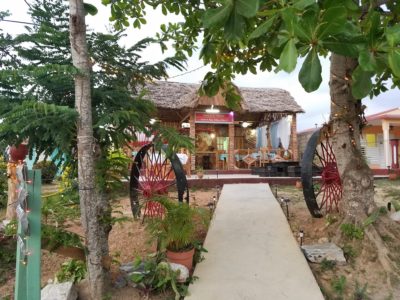
Super Charming Viñales
Apr. 11-14: I am totally happy I went to Viñales. Although I would caution you against going only to Havana and Viñales. Although it is not affluent by US standards, Viñales is the most affluent part of Cuba. You would not really see a cross section of the country, if you only visited Viñales.
Almost every single home and I do mean almost every single home, had the symbol outside its door to denote it was a casa particular. The good news is that tourists can always be certain to find a place to stay, even if they just roll in without a plan. The other good news is that tourism is supporting local families and not going the direction of large resorts. Viñales has managed to keep the same old school flavor. Even the new buildings have colonial architecture.
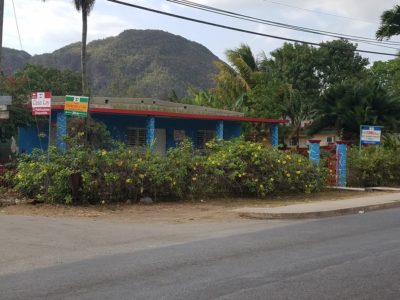
Notice Three Casa Particular Symbols – They Are Everywhere in Viñales
A Tourist Town
The bad news is, since almost everyone in the town works directly with tourists, it creates a bit of a bubble. Some people feel the city of Portland is a bubble and the entire state of Hawaii is a bubble, so bubbles and all things are relative and are not inherently bad.
I arrived via public transportation. It took longer than a cab ride but was about 10% of the cost. Plus, I met all sort of interesting people on the bus. I sat next to Anne, a German woman who embodies being a free spirit. She was up to date on American politics, as many Europeans are, at least more so than we are about their politics. She schooled me a bit about the state of affairs in Germany. We talked travel styles, families, and shared some of the places we have been. What was super cool is that there is an airline in Germany where you can buy plane tickets, but you don’t know the destination until afterwards. You can pay extra to exclude certain cities. That works a lot better in Europe than it does in the States. But I told you she was a free spirit!
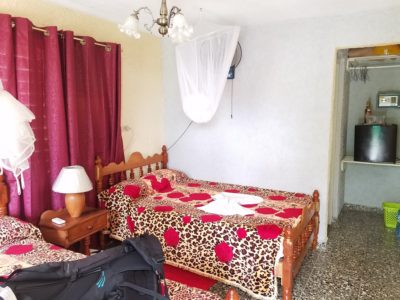
My Casa in Viñales
Señora Leibys, my host in Viñales, was at the bus station, which I was not expecting, but she walked me to her home, showed me around and gave me a smoothie to help me settle in. She immediately asked me what I wanted to do and let me know her husband could give me a tour. I wasn’t sure if she was trying to be accommodating or the pushy sales type. After a few days, I determined it was a little bit of both.
After getting grounded, I did decide on a few things and met the Señor, Papito. He spoke WAY too fast for me and I could not understand anything he said, which made me a little nervous for committing to a day with him.
The Viñales Mercado
With a half day left to explore, I headed out on my own. The mercado was the place for crafts. Many booths sold the same thing, but toy cars and guitars out of old soda bottles were amongst the most unique things. I picked up some beautiful wooden cooking utensils for myself and friends.
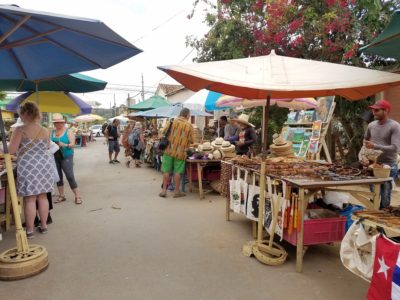
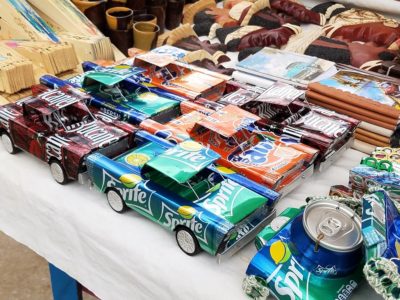
The Mercado Had Some Cool Repurposing Going On
Helping Out at the Tobacco Farm
The tobacco farm proved to be very interesting. If something involves learning about plants, I am interested. There didn’t appear to be official tours, so I headed into the fields and watched a farm worker, Ricardo, for a while, until he invited me to join him. I recall my herbal teacher Cascade saying “the best way to learn about plants when you travel is to watch others interacting with plants, and don’t speak.” This was one of her many pearls of wisdom.
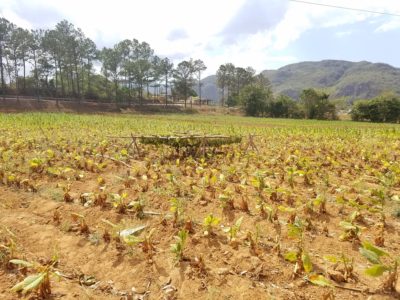
Viñales Is the Heart of Cuban Tobacco Country
For the next hour and change I worked in the field with Ricardo. I used a tiny scythe, which he called una melussa, to make upward cuts in the plants. He would correct me about the angle or, if I started to cut a plant too small for harvesting. Tall plants would yield three or four pieces that he hung over his arm upside down. Once his arm filled up, we walked over to the drying racks and he had a method of laying them all in one swoop and then straightening them out. And back to the fields we went to repeat the process again and again.
I will tell you if I had to bend over eight hours a day in that heat, tobacco farming would not be nearly as fun. Ricardo skillfully sharpened his tool on the wooden legs of the drying rack, much the same way a chef hones his or her knife. As far as I could see up into the barn, there were tobacco plants drying on the handcrafted racks. Ricardo told me that the leaves stay outside for three days, then three months in the barn to cure, then 6 months in a bag to get slightly fermented. So from seed to cigar is one full year. I picked up some unlabeled cigars, not because I planned on smoking them, but because they were too iconic to not have.
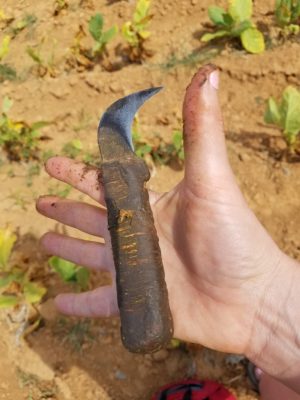
A Simple But Well Sharpened Tool
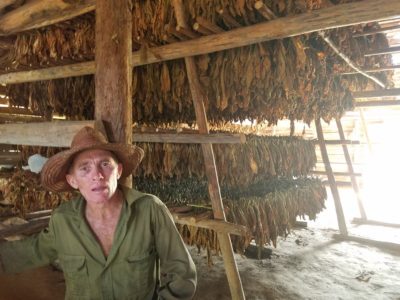
Ricardo In the Drying Shed
Exploring Viñales
The botanical gardens near my home was a natural go to. However, they were more of a wild garden, adorned with pieces of garbage like doll heads and rusty metal things. An artistic interpretation of a garden if you will.
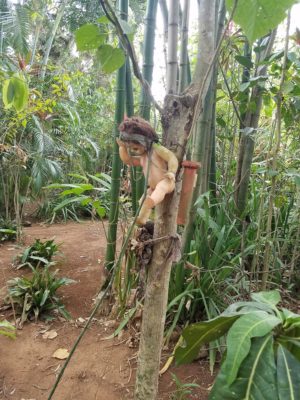
The Botanical Gardens Were on the Wild Side
I do believe Cubans appreciate recycling. Like so many places, the masses are drinking bottled water. But unlike many of those places, it’s rare to find garbage on the streets. In fact, I saw large onion sacks filled with empty water bottles. In some regards, Cuba is very progressive.
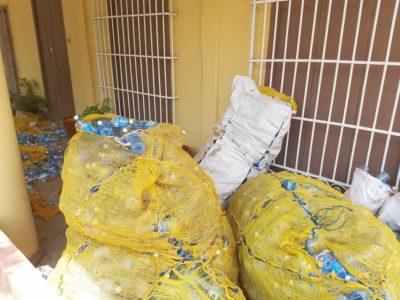
Almost Unheard of to Recycle in the Developing World
La Ermita was an upscale hotel I read about in the LP guide and when Papito mentioned it for watching sunsets, I was all in. I noticed it was the same brand hotel as where I had stayed in Soroa – Horizontales. I later noticed a couple other hotels with this brand and learned that they are all run by the government. It didn’t take me long to find the perfect spot under the sprawling tree on the lawn. Others came to gather and the bartender taking mojito orders soon followed. Tropical sunsets don’t last forever and I savored it to the fullest and headed down the hill on foot, smiling as horses trotted by.
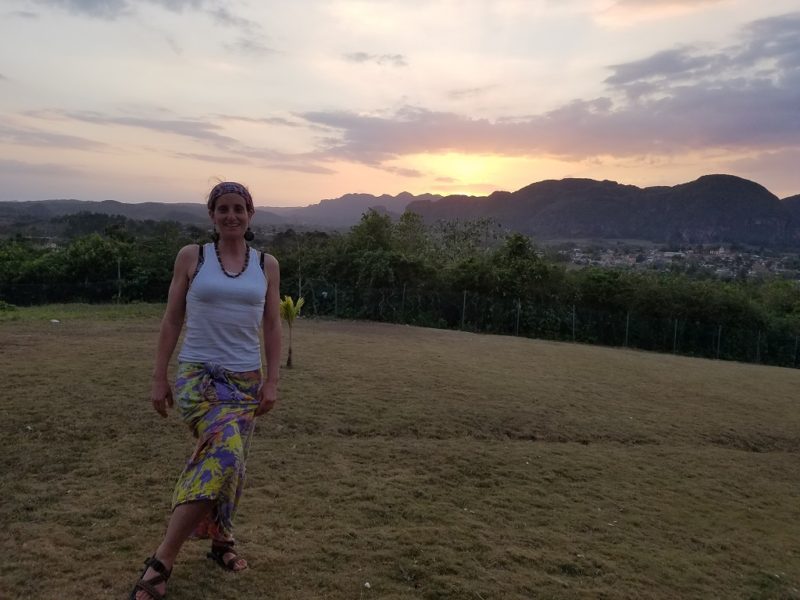
The Upscale La Ermita Is Primo for Sunset Viewing
Strolling through the neighborhoods and hanging out at the plaza at night are some of the most authentic ways to experience the local culture. I was told that there would be salsa lessons at 1 AM on the plaza. And some part of me really wanted to attend. But the pragmatic side of me won and I tucked into my casa long before 1 AM.
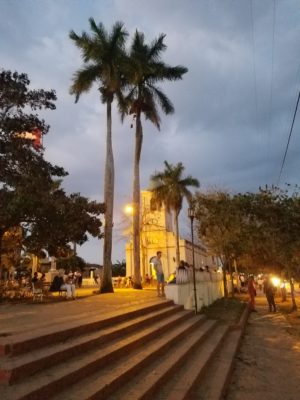
The Plaza (and Internet Hotspot) at Night
A Little Latin Machismo
Well, Papito started the car at 6 am and off we went to Los Aquavitos. I was not in the car for more than two minutes when he began the stronger than usual Latino machismo routine with me. Although it’s typical in the culture, I was still surprised, since he knew he would need to see me for the next few days around the Señora. I mostly pretended I didn’t know what he was talking about.
We sat atop the mountain for quite some time, watching the sky come to life. By the time the sun made it over the horizon we had touched upon all sorts of topics for conversation. I had asked him to speak mas despacio (more slowly) and today I could understand most of what he said.
We chatted about how seeing sunrises from scenic points are especial. He understood. We spoke about that he and the Señora do not have any children together, but he had one recently with another woman and that has made life muy complicado. I understood.
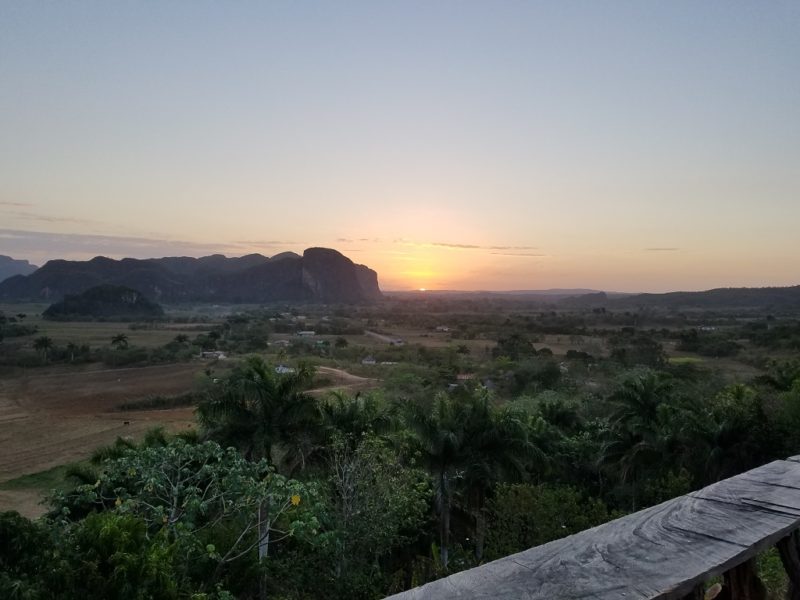
Getting Up Early Has its Rewards
Los Aquavitos
The property of Los Aquavitos was settled by a dozen or so families, but now only one remains. The property is extensive and has tobacco growing, with a drying room for the plants, and sculptures made of wood and metal. Many of the sculptures depicted animals or people or mermaids, but in a distorted and artistic form. The native kitchen with stone tools was of particular interest to me.
A Smattering of the Art at Los Aquavitos
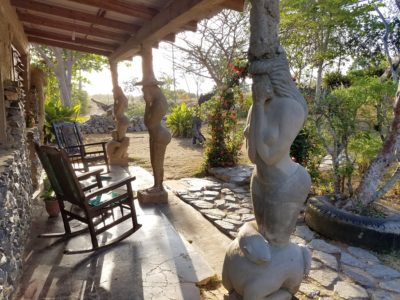
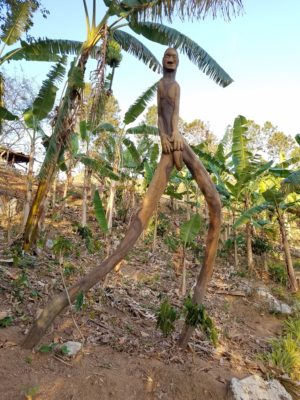
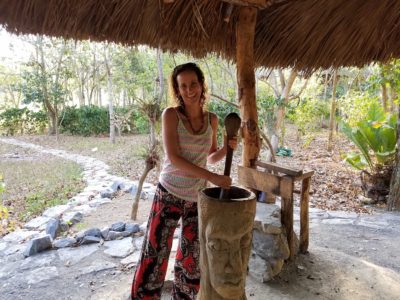
The Caves and Murals of Viñales
The nearby caves, Cuevos de Santo Tomas are worthwhile, if you are in Viñales. I have seen more impressive or unique caves in other places, but for checking out the region, why not?
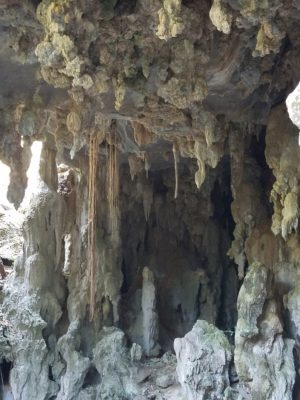
Crystal Formations Never Cease to Be in Awe
Another worthwhile place to visit is the Mural Prehistorica. It was painted in the 1960’s and depicts the archeological history of the region. The colors were bright, like the Cuban homes! It is cool to look at, and if you are feeling adventurous, take the trail to the right to get to the top.
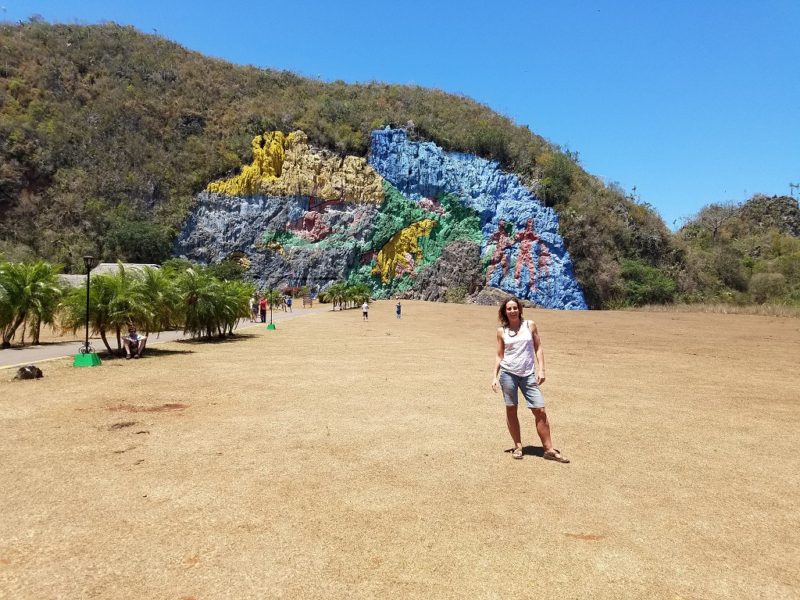
A Modern Mural Depicting Prehistoric Times
I stopped at the bar for a sugar free piña colada afterwards and discovered that without the sugar it was actually a healthful drink. I also discovered the Cuban way is to leave the rum out and offer it for the consumer to put in as a finishing touch. Interesting and very nice!
It was broiling so retreating to the casa particular for the mid-afternoon was wise. I pondered some of the notable aspects about the Cuban culture, and even more specifically, the things I had just seen on their street.
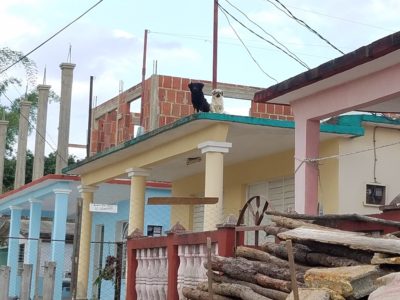
The Neighborhood Guard Dogs Yapped Nonstop
Papito and Liebys’ neighbor kept their two yappy dogs on their roof. They brought them up via ladder and they have been there ever since! Papito said both the Señor and Señora were loco. Let’s say it adds character to the street.
Then there were the traveling pepper salesmen who came to their house. They park in a hood, then walk around selling their wares.
And at the end of the block where I went for lunch, I inquired if there were a laundromat in town. The short answer was no, since they cannot be privately owned. Although, while I was I was sitting there, the waiter spoke with the woman doing laundry in the yard next and she said she’d do it and it would be ready in an hour.
All of these things are just the way things get done here. And, you know what, it all seems to work out pretty well, as quirky as it may seem.
Balcón de Valle Offers a Million Dollar View
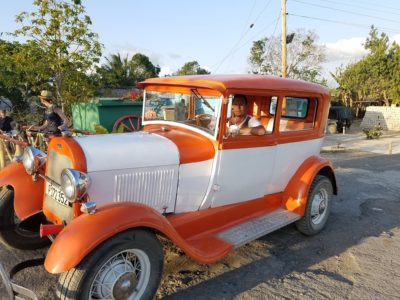
Want to Go Back in Time?
I tried to take a horse taxi up the hill, but none of them would stop for me, I think they were already delivering loads elsewhere. Instead I took a 1928 car (making the 1957 Chevy’s look new) up the hill to Balcón de Valle, a restaurant I found in the LP guide.
The view was worth the price of admission and if that view were in the US, the piña coladas alone would be $32. There was no written menu, but I had a choice of beef, lamb, chicken, fried fish – and all the trimmings. The server delivered fried plantain chips with a curried aioli, then a salad to get me started. But let’s get to the view.
Glorious, expansive, rich tones imprinted themselves in my mind. I was up above the tobacco fields and orange colored soils. The limestone karsts seemed almost within reach. The sun was setting off to my left. This was the same basic view as I had seen from La Ermita, but I somehow felt closer. Since the outdoor seating was built on stilts, I felt as though I was literally above it all (if I fell, it would be a long tumble down the cliff).
It had grown rather windy and I looked at the enclosed area maybe 30 feet back from me where some others were eating. But I decided to eat amidst the strong breezes and incorporate it into my experience. When I finished I was so stuffed, that I could not touch dessert, a simple yet attractive display of fresh fruit. Now for the real shocker- the piña colada, bottled water and fabulous meal all came to $11.
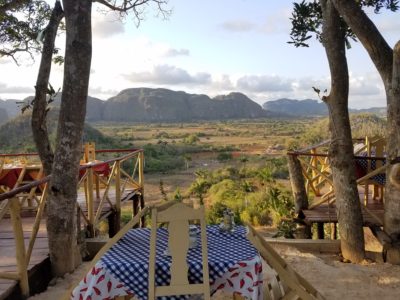
The Food Was Good Here
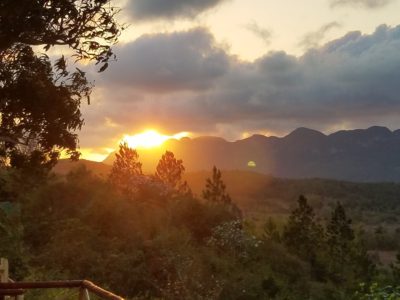
But the Scenery Stole the Show
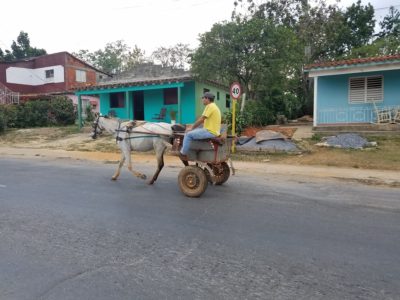
Horse Taxis Abound in Viñales
I walked home in the dark. Walking of course being an aid to assimilating a meal and being the best way of seeing a place. Before I got down the hill, a horse taxi did stop and offer me a ride. He was headed home, not fully in the direction I was headed. He told me to jump in and he’d just drop me off at the bottom of the hill. Although brief, I got a taste of the horse taxi experience!
My last full day in Viñales and I wanted to trek around by bicycle in the valley, which is primo biking terrain. Just like the waiter hooked me up with the laundress, Papito hooked me up with a bike. And it was in a lot better condition than I was expecting. In Cuba, whatever you need, someone’s got a friend who can help you.
But first I had breakfast made by Liebys, which was fruit from her yard. I asked Leibys about when she eats breakfast and she said whenever she is hungry. What do Cubans do regarding sharing meals? There is no tradition around eating together. Madre cooks and the family just eats as they feel like it. Maybe for a special occasion like a birthday, they all get together to eat. Just like the US!
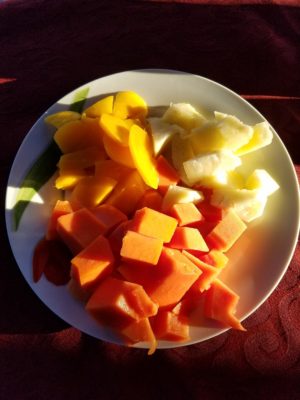
A Rainbow of Fruit for Breakfast
It really differs from Mexico or Western Europe, where food and family are so central to one’s existence. In general, I think the Cubans are pretty relaxed about certain things. They are Christian technically, but one of the least religious countries in the region. This may explain why they have a very low birthrate for a developing country. One, they feel secure about their needs, but also, religion does not play a big role in their lives.
I did take some time to talk to the woman who worked at the casa, recalling that the owners were the middle class. I gathered that the worker had four kids, and, when she was most recently pregnant, her husband left her. And now she is a single mom with no help. Sadly, I think these are the more common types of stories, once you get out of the tourist circuit.
The Rare “Ugly” Cuban
I was nine days into my trip before I had a negative interaction with a Cuban. And it turned out to be the only one in two weeks. Which speaks to how wonderful the Cubans are, but I should share this story just for truthfulness.
I encountered him at the bank that Leibys pointed out to me, to change more Canadian dollars to Cuban pesos. The door was controlled by a uniformed guard who admitted people one by one. There were maybe a dozen people in front of me, so I established my place in the non-linear line and waited my turn. In the meantime, maybe another dozen or more people showed up, including two British women.
When it got to be our turn, the guard, rather than admitting us, would let people in who were clearly after us. At some point, I squirmed my way forward and explained in Spanish that we had been there before all those other people. I could not understand his response, but with his stern look and his shoving the door shut when I spoke- I got the point. The Brits and I had theorized that maybe there was a different line once inside for changing foreign money.
But as time went on, we realized that somehow this was just normal business practice. One of the British women went to the bank next door, but the line was just as long and we didn’t really want to lose another 40 minutes waiting to see what would happen. We eventually got the gist from a few people that as long as there were Cubans in line, they would be allowed in first. If there were ever not a line, we would be helped. Needless to say, none of us wanted to spend the next four hours waiting, we all had days to get on with.
We eventually found a different place to change money and parted ways. It was not just that the Cubans were favored over us, but the way the guard was demeaning, pushy, and spoke in a derogatory manner to us that made the whole experience frustrating.
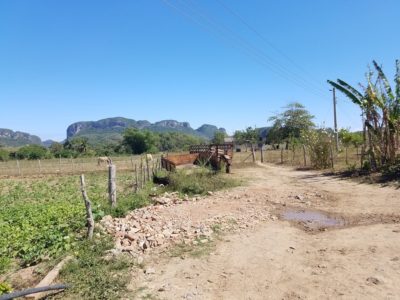
The Silent Valley Is Truly Just That
Biking In Viñales Valley
My frustration faded as I cruised off on my bike into the Valle de Silencia. I enjoyed twisting and turning down the dirt roads, especially when I arrived on a dead end and landed in front of someone’s porch. The owner was very sympathetic and steered me in the correct direction to get back to the road.
I found a tasty lunch at a pit stop in the valley, which was one of many in a road full of tourist attractions. There were more caves and such along the road, but I opted for going on a longer ride through the countryside. I landed at the river near a village called La Palma. I thought I found a private swimming hole.
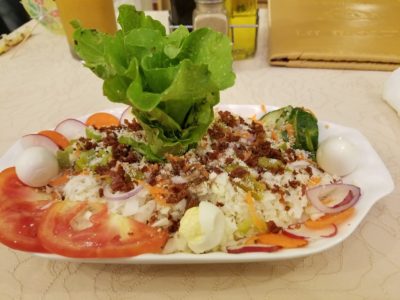
Cuban Food Is Simple and Sweet
A Delightful Picnic with Cuban Farm Families
It was private until a few families showed up for a picnic. And privacy be damned, I had the best afternoon cooking and visiting with them. The family totally adopted me, pointing at me and saying la familia. They were very intrigued, taking pictures of and with me.
They had a farm up the road and they loaded up their cart pulled by water buffalo and filled it with cooking supplies, a lot of chicks, a nursing pig and her fourteen mischievous piglets. The human children walked alongside the cart and ended up playing in the river all day.
I helped make a soup out of malanga root and spices and I grated tons of potatoes and plantains and helped fry them in rendered pig fat. It was TOO good!
I could have stayed and stayed, but with the sun setting, it was best I got riding 30 km back to Viñales. In my mind however, I was still one of the gang, piglets and all.
A Rural Cuban Family
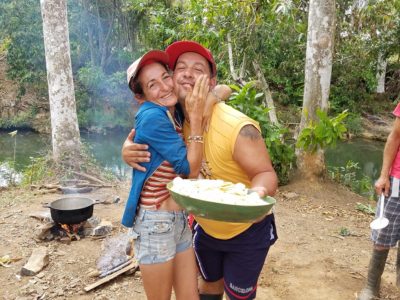
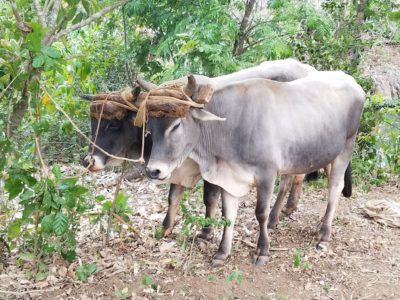
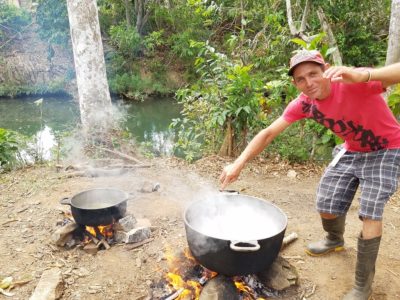
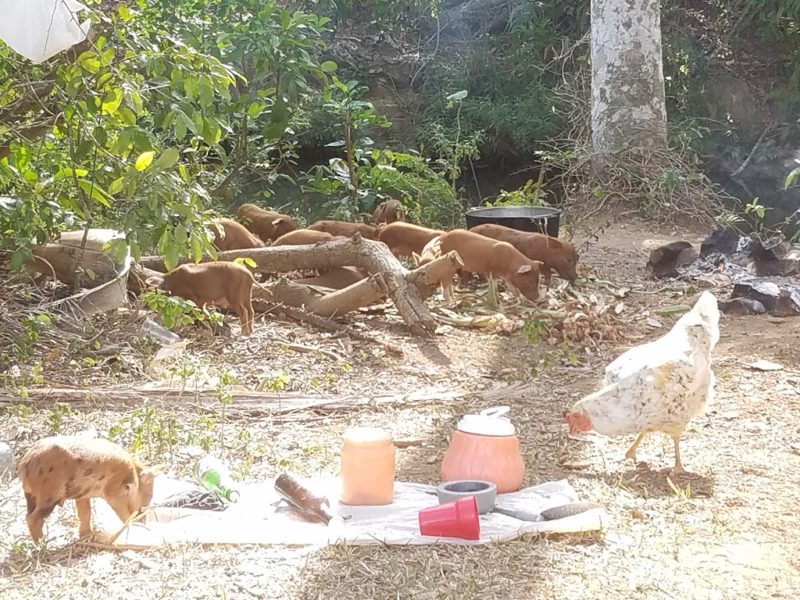
I Will Admit, I Fell in Love With the Piggies
Tidying up and getting ready for my next leg was all I had left to do. I did a final walk through town and ended up at the same restaurant I ate at a few days ago. The food was not that good, but I had gotten to know the waiter Miguel a bit and when we saw each other on the street, we couldn’t help but pick up where we left off.
Visiting with Miguel, Professor, Waiter, Fish Distributor, …
When I would ask him about why something was a certain way, he’d say “because it’s Cuba, things are not what they appear to be.” He shed a lot of light on how Cuba came to be what it is politically and what could be next. He acknowledged that Cuba is shifting toward capitalism, but was worried that with no regulation, there will be a lot of exploitation of the labor force and Cubans would need to fight for workers’ rights.
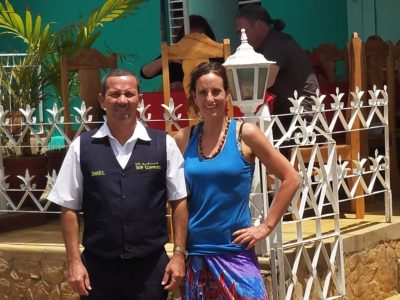
Miguel’s Backstory Had Me Endlessly Intrigued
Miguel was actually a language professor for over 20 years. He was from a nearby fishing village where he was the fish buying middle man for years. The extra money was important as being a professor only paid 25 CUC/month (about $30 USD). Having a second job to supplement income is pretty common among Cubans. Miguel was the middleman because fishermen are not allowed to sell directly to the restaurants. Now he has a plan to save up money as a waiter to buy his own boat and move back to his village, where he feels a strong sense of purpose and loyalty. I gifted him with a contribution toward that dream and he mentioned another American did the same about a month ago.
Papito was my taxi driver to Palma Rubio. By this point, we were laughing together at his ridiculous displays of Latino machismo. Although his behavior was obnoxious, I have to say that it was amusing. We did hit a private swimming hole on the way, which was a total delight. Our conversation touched on the tobacco farming culture, working with tourists, and hitchhiking culture (since he stopped for a woman holding a baby).
We arrived in Palma Rubio and he helped make the transition to my new casa particular a great one.
Click here to see what I did next in Palma Rubia.
And what I was up to in Havana and Soroa.
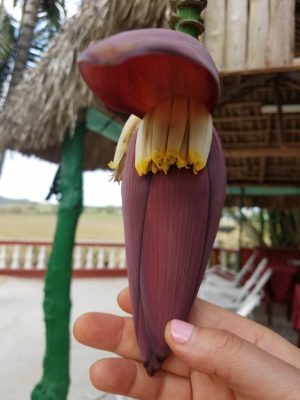
The Beige Part Becomes the Bananas
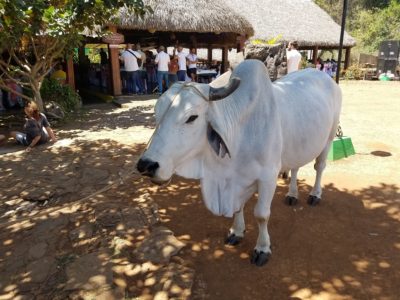
The Water Buffalo Had Gentle Energy
